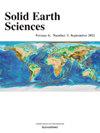Hydrogeochemical characterization and quality assessment of groundwater resources in Amtali Upazila, Barguna: A study of coastal Bangladesh
IF 2
4区 地球科学
Q3 GEOSCIENCES, MULTIDISCIPLINARY
引用次数: 0
Abstract
The coastal regions of Bangladesh are highly vulnerable to saline water intrusion due to excessive groundwater abstraction, rising sea levels, and frequent tropical disasters. Among these, Amtali Upazila in Barguna District faces significant challenges in maintaining groundwater quality, necessitating a comprehensive assessment. This study evaluates the hydrogeochemical characteristics of groundwater and assesses its suitability for drinking and irrigation. To achieve this, groundwater samples collected from a deep aquifer (260–350 m) across 23 locations were analyzed using hydrogeochemical, geospatial, and statistical methods. The major ionic composition follows the order Na+ > Mg2+ > K+ > Ca2+ and HCO3– > Cl− > SO42− > NO3– for cations and anions, respectively. Piper and Gibbs diagrams classify the groundwater (GW) as Na–HCO3 type, with ion exchange and rock–water interactions being the dominant geochemical processes. Water quality indices, including the Water Quality Index (WQI) and Sodium adsorption ratio (SAR), Sodium Concentration (SC), and Kelly's Ratio (KR), indicate that 73.9 % of the samples are suitable for drinking, whereas most samples are unsuitable for irrigation. Multivariate statistical analysis (correlation matrix, cluster analysis, and principal component analysis) confirms that geogenic processes primarily influence groundwater quality. The findings provide critical insights for policymakers and local authorities in formulating sustainable groundwater management strategies, ensuring safe drinking water, and mitigating irrigation challenges in the region.
巴古纳Amtali Upazila地下水资源的水文地球化学特征和质量评价:孟加拉国沿海地区的研究
由于过度抽取地下水、海平面上升和频繁的热带灾害,孟加拉国沿海地区极易受到盐水入侵的影响。其中,巴尔古纳区的Amtali Upazila在维持地下水质量方面面临重大挑战,需要进行全面评估。研究评价了地下水的水文地球化学特征,评价了地下水的饮用和灌溉适宜性。为了实现这一目标,从23个地点的深层含水层(260-350米)收集的地下水样本使用水文地球化学、地理空间和统计方法进行了分析。主要离子组成为:Na+ >;Mg2 +比;K +比;Ca2+和HCO3 - >;Cl−祝辞SO42−祝辞NO3 -分别表示阳离子和阴离子。Piper图和Gibbs图将地下水划分为Na-HCO3型,以离子交换和岩水相互作用为主要的地球化学过程。水质指数(WQI)、钠吸附比(SAR)、钠浓度(SC)、凯利比(KR)等水质指标表明,73.9%的样品适合饮用,大部分样品不适合灌溉。多变量统计分析(相关矩阵、聚类分析和主成分分析)证实了地质过程主要影响地下水质量。研究结果为决策者和地方当局制定可持续地下水管理战略、确保安全饮用水和缓解该地区的灌溉挑战提供了重要见解。
本文章由计算机程序翻译,如有差异,请以英文原文为准。
求助全文
约1分钟内获得全文
求助全文
来源期刊

Solid Earth Sciences
GEOSCIENCES, MULTIDISCIPLINARY-
CiteScore
3.60
自引率
5.00%
发文量
20
审稿时长
103 days
 求助内容:
求助内容: 应助结果提醒方式:
应助结果提醒方式:


